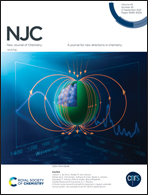The degradation of methylene blue dye using copper-doped hydroxyapatite encapsulated into polycaprolactone nanofibrous membranes†
Abstract
The development of advanced compositions to remove contamination from water resources has become a global challenge in the last decades. Herein, nanofibrous membranes of polycaprolactone (PCL) incorporated with hydroxyapatite (HAP) that was modified with different amounts of Cu(II) ions have been fabricated. The structures, morphologies, and surface roughnesses of the constructed (Cu–HAP@PCL) membranes were characterized via a wide range of spectroscopic, microscopic, and surface science tools. Probing the surface morphology revealed that these membranes exist as networked fibers with various diameters ranging from 0.45–1.5 to 0.2–0.9 μm, along with maximum height roughnesses (Rt) of 266.2 to 463 nm for compositions having increased amounts of Cu(II) ions, respectively. The mechanical behavior results attested that the elasticity of the membranes was enhanced upon the addition of Cu(II) dopants, and the maximum strain before break reached nearly 125.59 ± 6.5% for the sample containing the highest Cu(II) content. As for biological applications, the fabricated Cu–HAP@PCL membranes showed powerful antibacterial potency, with activity areas of 14.5 ± 1.7 and 14.7 ± 1.6 mm achieved against E. coli and S. aureus, respectively. Further, the degradation efficiency of methylene blue (MB) dye indicated that the highest degradations of 88.6%, 89.4%, 91.0%, 91.1%, and 94.3% were accomplished after 70 min of irradiation under visible light using the fabricated Cu–HAP@PCL membranes. The efficient performance of the fabricated Cu–HAP@PCL membranes in biologically and environmentally related persistent problems encourages their potential utilization in wastewater management and microbial treatments.



 Please wait while we load your content...
Please wait while we load your content...